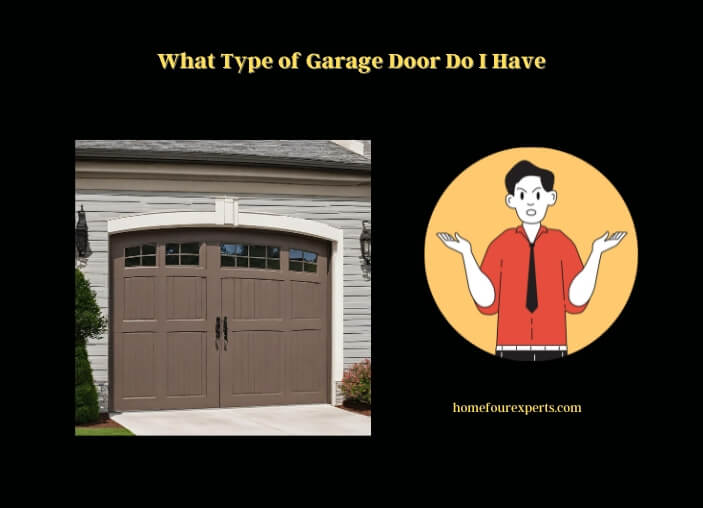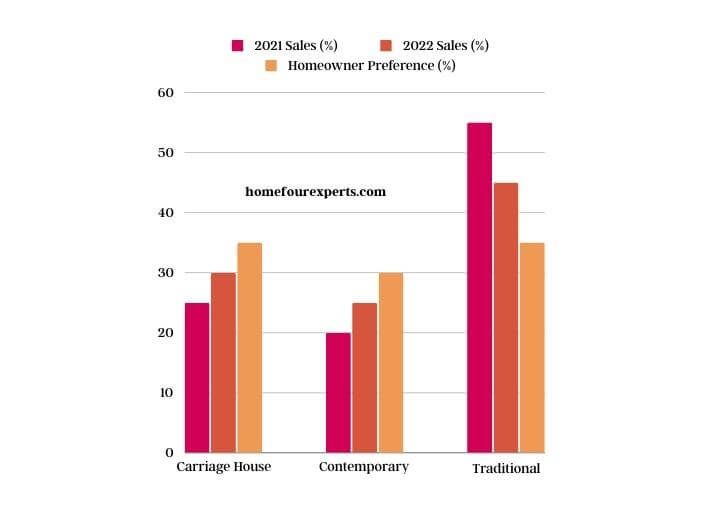To identify your garage door type, consider its opening mechanism and material. Garage doors vary in design, functionality, and the materials used in their construction.
Garage doors are essential for home security and aesthetic appeal. They come in various types, each with unique features and benefits. The five main types are tilt-up, side-hinged, sectional, roll-up, and those differentiated by material.
Tilt-up garage doors are a single solid piece that tilts to open, pivoting outwards and upwards. They are simple in design and easy to operate, making them a popular choice for many homeowners. The tilt-up garage door opener is a mechanism that aids in the smooth lifting and lowering of the door, enhancing convenience and efficiency.
Side-hinged garage doors resemble traditional barn doors. They swing open and closed from a hinged frame on either side of the opening. This style is ideal for those who prefer a classic or rustic look and have sufficient driveway space to accommodate the swinging motion.

Sectional garage doors are composed of panel sections connected with hinges. As the door opens and closes, wheels at the edge of each panel roll inside a vertical track on each side of the door opening. This type is popular due to its space-saving design, as it opens vertically and does not swing outwards. Sectional doors come in various styles and materials, offering versatility in design.
Roll-up garage doors are designed with horizontal slats that roll up into a coil above the door opening. This design is space-efficient and commonly used in commercial settings but is also suitable for residential garages with limited headroom.
The materials used in garage doors include wood, steel, aluminum, fiberglass, and vinyl. Each material offers different benefits in terms of durability, maintenance, insulation, and cost.
For a more detailed understanding of these garage door types, including their specific advantages and considerations, read the comprehensive article below. This information will assist you in making an informed decision about the best garage door for your home.
Identifying Your Garage Door Type – A Detailed Guide
Different Garage Door Mechanisms
Tilt-Up Garage Doors
Tilt-up garage doors are all about simplicity and ease of use. Imagine a single, solid door that smoothly tilts up into your garage’s ceiling space. It’s like lifting a single large panel, which pivots out and up. The charm of this design lies in its straightforwardness. However, it does require some space in front of the garage to operate effectively, so it might not be the best choice if your driveway is short.
Sectional Garage Doors
Sectional garage doors are the go-to for many homeowners. Picture several horizontal panels, hinged together, that bend and curve as the door opens. These doors rise vertically, with no swing out, saving you precious driveway space. They’re incredibly versatile, fitting well with a range of house styles. Plus, they come in a variety of materials and finishes, making them a customizable option for your home.
Roll-Up Garage Doors
Roll-up doors are the space savers of the garage door world. They consist of many small sections joined together that roll around a drum above the door opening. These doors are particularly useful in commercial settings or homes with limited ceiling space. They’re sturdy, withstand heavy usage, and require minimal maintenance, making them a practical choice for many.
Side-Hinged Garage Doors
Side-hinged garage doors hark back to the traditional barn doors. They swing open from a hinged frame on either side of the opening, much like the doors in your home. This style suits homes with enough driveway space to accommodate the door’s swing. They offer a classic aesthetic and are often chosen for their old-world charm.
Materials Used in Garage Doors
Wooden Garage Doors
Wooden garage doors are the epitome of classic beauty. They bring warmth and character to any home’s exterior. However, they do need more maintenance than other materials, like regular staining or painting to protect against the elements. But for many, the aesthetic appeal of wood outweighs these extra upkeep tasks.
Steel and Aluminum Doors
Steel and aluminum doors are the tough guys in the garage door world. They’re durable, low maintenance, and come with various insulation options. Steel doors can mimic wood’s look without the upkeep, while aluminum is lightweight and rust-resistant, ideal for coastal areas. Both materials offer longevity and security, making them a popular choice.
Fiberglass and Vinyl Options
Fiberglass and vinyl garage doors are the rising stars in the market. They resist denting, cracking, and rusting, making them a durable option. These materials are also low maintenance and can mimic the texture and color of wood without the associated upkeep. They’re a smart choice for homeowners looking for longevity and style.
Comparison of Garage Door Materials
| Material | Durability | Maintenance Requirements | Insulation Values |
| Wood | Medium | High | Low-Medium |
| Steel | High | Low | High |
| Aluminum | Medium | Low | Medium |
| Fiberglass | High | Low | Medium-High |
| Vinyl | High | Very Low | Medium-High |

Popular Garage Door Styles and Their Features
Carriage House Doors
Carriage house doors blend historical charm with modern functionality. They mimic the look of old carriage house doors that swung open but operate with the convenience of modern sectional technology. These doors add a touch of elegance and old-world style to any home, making them a favorite for those looking to enhance their home’s curb appeal.
Contemporary Garage Doors
Contemporary garage doors are all about clean lines and modern materials. They often feature glass panels and metal frames, offering a sleek, minimalist look. These doors are perfect for modern homes and can be customized in a range of colors and finishes to match your home’s unique style.
Traditional Raised-Panel Doors
Traditional raised-panel doors are the classic American garage door. They feature a series of raised panels that add depth and texture to the door’s surface. Available in various materials and finishes, these doors are versatile and fit well with most home styles. They’re a timeless choice that never goes out of style.
Garage Door Style Popularity Trends
| Style | 2021 Sales (%) | 2022 Sales (%) | Homeowner Preference (%) |
| Carriage House | 25 | 30 | 35 |
| Contemporary | 20 | 25 | 30 |
| Traditional | 55 | 45 | 35 |

Advanced Features in Modern Garage Doors
Insulation and Energy Efficiency
Insulated garage doors are a game-changer for energy efficiency in your home. They keep your garage warmer in winter and cooler in summer, which can be a big deal if your garage is attached to your house. This insulation also reduces noise and can lower your energy bills, making it a smart investment.
Smart Garage Door Openers
Smart garage door openers are revolutionizing how we interact with our garages. With features like remote operation via smartphone and integration with home security systems, these openers offer convenience and peace of mind. They’re perfect for those who value technology and security in their homes.
Customization Options
Today’s garage doors offer endless customization options. From window inserts and hardware choices to custom colors and finishes, you can tailor your garage door to perfectly match your home’s style. This personalization allows homeowners to create a unique look that stands out in their neighborhood.
Smart Garage Door Opener Adoption Rates
| Year | Adoption Rate (%) | Market Share by Brand (%) |
| 2021 | 35 | 40 |
| 2022 | 45 | 50 |

Maintenance and Upkeep of Garage Doors
Routine Maintenance Tips
Regular maintenance is key to keeping your garage door in top shape. This includes simple tasks like lubricating moving parts, checking for wear and tear, and ensuring the door is balanced. By keeping up with these tasks, you can extend the life of your garage door and avoid costly repairs down the line.
Common Issues and Troubleshooting
Even with regular maintenance, garage doors can have issues. Common problems include noisy operation, sticking, or uneven movement. Most of these can be fixed with some basic troubleshooting, like realigning sensors or adjusting tension springs. Knowing how to handle these minor issues can save you time and money.
FAQs
Can Paint Affect My Garage Door’s Functionality?
Painting your garage door can indeed affect its functionality, especially if it’s not done correctly. Adding layers of paint can interfere with the door’s balance and the smoothness of its operation. For instance, if paint gets into the tracks or on the rollers, it can cause sticking or uneven movement. It’s crucial to use the right type of paint and apply it carefully, avoiding any hardware or moving parts. Additionally, the weight of the paint can unbalance a door, particularly in the case of lighter materials like aluminum. It’s always a good idea to consult with a professional before undertaking a painting project on your garage door.
How Does Weather Impact Different Garage Door Types?
Weather can significantly impact garage doors, with each type responding differently. Wooden doors, for instance, are susceptible to warping, rotting, or expanding due to moisture and extreme temperatures. Metal doors, like steel or aluminum, can suffer from corrosion or rust, especially in coastal areas with salty air. Fiberglass and vinyl are more resistant to weather-related damage but can become brittle in extreme cold. Insulation is another factor; well-insulated doors can help maintain temperature and prevent weather-related wear. Regular maintenance, like sealing and lubricating, can mitigate these effects and prolong the life of your garage door.
How can I determine what type of garage door I have if it’s sticking when closing?
If your garage door is sticking when closing, it could be due to common causes for sticking garage doors such as misaligned tracks, damaged rollers, or a buildup of dirt and debris. To determine the type of garage door you have, check the manufacturer’s label or consult the original paperwork.
What Is the Lifespan of Different Garage Door Types?
The lifespan of a garage door depends on the material, quality, and maintenance. On average, a well-maintained garage door can last between 15 to 30 years. Wooden doors may require more frequent maintenance and can last around 15 to 20 years. Steel and aluminum doors, if properly maintained to prevent rust and corrosion, can last up to 20 or more years. Fiberglass and vinyl doors are known for their longevity, often lasting over 20 years with minimal maintenance. Regular inspections, cleaning, and prompt repairs are key to maximizing the lifespan of any garage door.
How Can I Enhance My Garage Door’s Security?
Enhancing your garage door’s security is vital for protecting your home. Start by ensuring the door and its hardware are in good condition. A sturdy, well-maintained door is harder to breach. Upgrading to a modern garage door opener with rolling code technology can prevent unauthorized access. Adding extra locks, especially for manual doors, can also deter break-ins. For smart home enthusiasts, integrating your garage door with a home security system offers additional monitoring and control. Regularly inspecting and maintaining the door’s integrity, including the tracks, rollers, and springs, is essential for ensuring it remains a strong barrier.
What Are the Signs of an Unbalanced Garage Door?
An unbalanced garage door can be a significant safety hazard. Signs of an unbalanced door include uneven hanging when open, difficulty in opening or closing, or a door that closes too quickly or slowly. You might also notice unusual noises during operation. Testing the balance is simple: disconnect the opener and manually open the door halfway. A balanced door will stay in place, while an unbalanced one will fall or rise. It’s crucial to address this issue promptly, as an unbalanced door can strain the opener and pose a risk of falling, potentially causing injury or damage.
How Does Insulation Affect Garage Door Performance?
Insulation in a garage door plays a crucial role in its performance, particularly in terms of energy efficiency and noise reduction. Insulated doors help maintain a consistent temperature in the garage, which is beneficial if the garage is attached to your home or used as a workspace. This can lead to lower energy costs, as your heating or cooling system doesn’t have to work as hard. Additionally, insulation can dampen street noise, making your garage a quieter environment. The type of insulation (polystyrene or polyurethane) and its R-value (a measure of thermal resistance) are important factors to consider for optimal performance.
Are There Eco-Friendly Garage Door Options?
Eco-friendly garage door options are increasingly available, catering to environmentally conscious homeowners. Doors made from sustainable or recycled materials are one option. For instance, some wooden doors are made from reclaimed wood or sustainably sourced timber. Steel and aluminum doors often contain a significant percentage of recycled materials. Another aspect is energy efficiency; doors with high insulation values can reduce energy consumption. Additionally, choosing a durable door with a long lifespan reduces the need for replacement and waste. When replacing an old door, recycling or repurposing the materials can also contribute to eco-friendly practices.
In this guide, we’ve walked through the different types of garage doors, their materials, and styles. We’ve seen how each type has its own set of features and benefits, from the classic charm of wooden doors to the modern convenience of smart openers. We’ve also covered the importance of regular maintenance to ensure your garage door functions smoothly for years to come. With this knowledge, you’re now equipped to make an informed decision about the best garage door for your home.
About This Writer

Hi, I am Eric Devin and I am a professional interior architect. Since childhood, I've always enjoyed DIY projects! And, I have loved to solve simple household problems using essential tools and equipment. I have also acquired a lot of information about basic household tools settings by working with contractors.